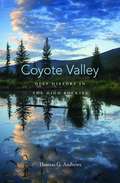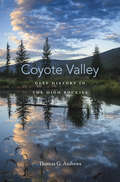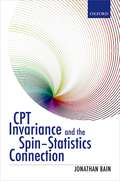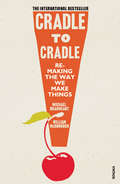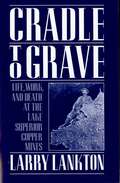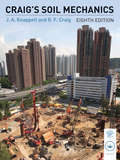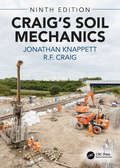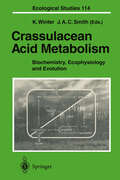- Table View
- List View
Coyote America: A Natural and Supernatural History
by Dan FloresThe New York Times best-selling account of how coyotes--long the target of an extermination policy--spread to every corner of the United States Finalist for the PEN/E.O. Wilson Literary Science Writing Award"A masterly synthesis of scientific research and personal observation." -Wall Street JournalLegends don't come close to capturing the incredible story of the coyote In the face of centuries of campaigns of annihilation employing gases, helicopters, and engineered epidemics, coyotes didn't just survive, they thrived, expanding across the continent from Alaska to New York. In the war between humans and coyotes, coyotes have won, hands-down. Coyote America is the illuminating five-million-year biography of this extraordinary animal, from its origins to its apotheosis. It is one of the great epics of our time.
Coyote Valley: Deep History in the High Rockies
by Thomas G. AndrewsThomas Andrews drills deep into the many pressures that have reshaped a small stretch of North America, from the ice age to the advent of the Anthropocene and controversies over climate change. He brings to the surface lessons about the critical relationships to land, climate, and species that only seemingly unimportant places on Earth can teach.
Coyote Valley: Deep History in the High Rockies
by Thomas G. AndrewsThomas Andrews drills deep into the many pressures that have reshaped a small stretch of North America, from the ice age to the advent of the Anthropocene and controversies over climate change. He brings to the surface lessons about the critical relationships to land, climate, and species that only seemingly unimportant places on Earth can teach.
CPT Invariance and the Spin-Statistics Connection
by Jonathan BainThis book seeks to answer the question "What explains CPT invariance and the spin-statistics connection?" These properties play foundational roles in relativistic quantum field theories (RQFTs), are supported by high-precision experiments, and figure into explanations of a wide range of phenomena, from antimatter, to the periodic table of the elements, to superconductors and superfluids. They can be derived in RQFTs by means of the famous CPT and Spin-Statistics theorems; but, the author argues, these theorems cannot be said to explain these properties, at least under standard philosophical accounts of scientific explanation. This is because there are multiple, in some cases incompatible, ways of deriving these theorems, and, secondly, because the theorems fail for the types of theories that underwrite the empirical evidence: non-relativistic quantum theories, and realistic interacting RQFTs. The goal of this book is to work towards an understanding of CPT invariance and the spin-statistics connection by first providing an analysis of the necessary and sufficient conditions for these properties, and second by advocating a particular account of explanation appropriate for this context.
CR Manifolds and the Tangential Cauchy Riemann Complex (Studies in Advanced Mathematics)
by Al BoggessCR Manifolds and the Tangential Cauchy Riemann Complex provides an elementary introduction to CR manifolds and the tangential Cauchy-Riemann Complex and presents some of the most important recent developments in the field. The first half of the book covers the basic definitions and background material concerning CR manifolds, CR functions, the tangential Cauchy-Riemann Complex and the Levi form. The second half of the book is devoted to two significant areas of current research. The first area is the holomorphic extension of CR functions. Both the analytic disc approach and the Fourier transform approach to this problem are presented. The second area of research is the integral kernal approach to the solvability of the tangential Cauchy-Riemann Complex. CR Manifolds and the Tangential Cauchy Riemann Complex will interest students and researchers in the field of several complex variable and partial differential equations.
CR Manifolds and the Tangential Cauchy Riemann Complex (Studies in Advanced Mathematics)
by Al BoggessCR Manifolds and the Tangential Cauchy Riemann Complex provides an elementary introduction to CR manifolds and the tangential Cauchy-Riemann Complex and presents some of the most important recent developments in the field. The first half of the book covers the basic definitions and background material concerning CR manifolds, CR functions, the tangential Cauchy-Riemann Complex and the Levi form. The second half of the book is devoted to two significant areas of current research. The first area is the holomorphic extension of CR functions. Both the analytic disc approach and the Fourier transform approach to this problem are presented. The second area of research is the integral kernal approach to the solvability of the tangential Cauchy-Riemann Complex. CR Manifolds and the Tangential Cauchy Riemann Complex will interest students and researchers in the field of several complex variable and partial differential equations.
A Crack in the Edge of the World: The Great American Earthquake of 1906 (Wheeler Hardcover Ser.)
by Simon WinchesterA burgeoning new city is built on the dreams of the American gold rush. It is also built upon a landscape that has been stretching, sliding and breaking apart for millennia. In 1906 the dreams of this city came crashing down beneath the rippling wave of a horrifying earthquake that turned roads into great rippling rivers, that set buildings ablaze for days on end, that made homes collapse upon themselves. Simon Winchester's breathtaking story delves deep beneath the surface of the earth and explains to us why the world moves as it does; and breaks apart with such devastating results. At the same time he never lets us forget the human story: what happened in this new, seemingly blessed city on the 18th April 1906. As he vividly portrays the lives of the people who suffered and survived the devastation he also tells a universal story: the hubris of man as he ignores the warnings of nature and how we respond and try to understand the world around us. Compelling, moving and enlightening, Simon Winchester brings to light the world beneath our feet and through the story of this one terrifying event one hundred years ago, begins to make sense of our world now.
Cracking the Carbon Code: The Key to Sustainable Profits in the New Economy
by T. TamminenHolds critical information that is needed by anyone who wants to understand how to make money from 'green' technology and how to avoid investments that will soon suffer from hidden carbon liabilities. Readers will learn to de-code a crucial component of this new economic driver - carbon credits, the world's first common currency.
Crackling Noise: Statistical Physics of Avalanche Phenomena
by Stefano ZapperiThe response of materials and the functioning of devices is often associated with noise. In this book, Stefano Zapperi concentrates on a particular type of noise, known as crackling noise, which is characterized by an intermittent series of broadly distributed pulses. While representing a nuisance in many practical applications, crackling noise can also tell us something useful about the microscopic processes ruling the materials behavior. Each crackle in the noise series usually corresponds to a localized impulsive event, an avalanche, occurring inside the material. A distinct statistical feature of crackling noise, and of the underlying avalanche behavior, is the presence of scaling, observed as power-law distributed noise pulses, long-range correlation, and scale free spectra. These are the hallmarks of critical phenomena and phase transitions. This work summarizes the current understanding of crackling noise, reviewing research undertaken in the past 30 years, from the early and influential ideas on self-organized criticality in sandpile models, to more modern studies on disordered systems. Crackling Noise covers the main theoretical models used to investigate avalanche phenomena, describes the statistical tools needed to analyze crackling noise, and provides a detailed discussion of a set of relevant examples of crackling noise in materials science. These include acoustic emission in fracture, strain bursts in amorphous and crystal plasticity, granular avalanches, magnetic noise in ferromagnets and superconductors, and fluid flow in porous media. The book concludes by considering the wider application of these models in the natural sciences.
Cradle of Life: The Discovery of Earth's Earliest Fossils
by J. William SchopfOne of the greatest mysteries in reconstructing the history of life on Earth has been the apparent absence of fossils dating back more than 550 million years. We have long known that fossils of sophisticated marine life-forms existed at the dawn of the Cambrian Period, but until recently scientists had found no traces of Precambrian fossils. The quest to find such traces began in earnest in the mid-1960s and culminated in one dramatic moment in 1993 when William Schopf identified fossilized microorganisms three and a half billion years old. This startling find opened up a vast period of time--some eighty-five percent of Earth's history--to new research and new ideas about life's beginnings. In this book, William Schopf, a pioneer of modern paleobiology, tells for the first time the exciting and fascinating story of the origins and earliest evolution of life and how that story has been unearthed. Gracefully blending his personal story of discovery with the basics needed to understand the astonishing science he describes, Schopf has produced an introduction to paleobiology for the interested reader as well as a primer for beginning students in the field. He considers such questions as how did primitive bacteria, pond scum, evolve into the complex life-forms found at the beginning of the Cambrian Period? How do scientists identify ancient microbes and what do these tiny creatures tell us about the environment of the early Earth? (And, in a related chapter, Schopf discusses his role in the controversy that swirls around recent claims of fossils in the famed meteorite from Mars.) Like all great teachers, Schopf teaches the non-specialist enough about his subject along the way that we can easily follow his descriptions of the geology, biology, and chemistry behind these discoveries. Anyone interested in the intriguing questions of the origins of life on Earth and how those origins have been discovered will find this story the best place to start.
Cradle to Cradle: (Patterns of the Planet) (Patterns Of Life Ser.)
by Michael Braungart William McDonoughRecycling is good, isn’t it? In this visionary book, chemist Michael Braungart and architect William McDonough challenge this status quo and put forward a manifesto for an intriguing and radically different philosophy of environmentalism."Reduce, reuse, recycle”. This is the standard “cradle to grave” manufacturing model dating back to the Industrial Revolution that we still follow today. In this thought-provoking read, the authors propose that instead of minimising waste, we should be striving to create value. This is the essence of Cradle to Cradle: waste need not to exist at all. By providing a framework of redesign of everything from carpets to corporate campuses, McDonough and Braungart make a revolutionary yet viable case for change and for remaking the way we make things.
Cradle to Grave: Life, Work, and Death at the Lake Superior Copper Mines
by Larry LanktonConcentrating on technology, economics, labor, and social history, Cradle to Grave documents the full life cycle of one of America's great mineral ranges from the 1840s to the 1960s. Lankton examines the workers' world underground, but is equally concerned with the mining communities on the surface. For the first fifty years of development, these mining communities remained remarkably harmonious, even while new, large companies obliterated traditional forms of organization and work within the industry. By 1890, however, the Lake Superior copper industry of upper Michigan started facing many challenges, including strong economic competition and a declining profit margin; growing worker dissatisfaction with both living and working conditions; and erosion of the companies' hegemony in a district they once controlled. Lankton traces technological changes within the mines and provides a thorough investigation of mine accidents and safety. He then focuses on social and labor history, dealing especially with the issue of how company paternalism exerted social control over the work force. A social history of technology, Cradle to Grave will appeal to labor, social and business historians.
Crafting Innovative Places for Australia’s Knowledge Economy
by Edward J. Blakely Richard HuThis book integrates planning, policy, economics, and urban design into an approach to crafting innovative places. Exploring new paradigms of innovative places under the framework of globalisation, urbanisation, and new technology, it argues against state-centric policies to innovation and focuses on how a globalized approach can shape innovative capacity and competitiveness. It notably situates the innovative place making paradigm in a broader context of globalisation, urbanisation, the knowledge economy and technological advancement, and employs an international perspective that includes a wide range of case studies from America, Europe, Asia, and Australia. Developing a co-design and co-creation paradigm that integrates governments, the private sector and the community into shared understanding and collaborative action in crafting innovative places, it discusses place-based innovation in Australian context to inform policy making and planning, and to contribute to policy debates on programs of smart cities and communities.
Craig's Soil Mechanics
by R. F. Craig Jonathan KnappettNow in its eighth edition, this bestselling text continues to blend clarity of explanation with depth of coverage to present students with the fundamental principles of soil mechanics. From the foundations of the subject through to its application in practice, Craig’s Soil Mechanics provides an indispensable companion to undergraduate courses and beyond. New to this edition: Rewritten throughout in line with Eurocode 7, with reference to other international standards Restructured into two major sections dealing with the basic concepts and theories in soil mechanics and the application of these concepts within geotechnical engineering design New topics include limit analysis techniques, in-situ testing, and foundation systems Additional material on seepage, soil stiffness, the critical state concept, and foundation design Enhanced pedagogy including a comprehensive glossary, learning outcomes, summaries, and visual examples of real-life engineering equipment Also new to this edition is an extensive companion website comprising innovative spreadsheet tools for tackling complex problems, digital datasets to accompany worked examples and problems, a password-protected solutions manual for lecturers covering the end-of-chapter problems, weblinks, extended case studies, and more.
Craig's Soil Mechanics
by Jonathan Knappett R.F. CraigCraig’s Soil Mechanics continues to evolve and remain the definitive text for civil engineering students worldwide. It covers fundamental soil mechanics and its application in applied geotechnical engineering from A to Z and at the right depth for an undergraduate civil engineer, with sufficient extension material for supporting MSc level courses, and with practical examples and digital tools to make it a useful reference work for practising engineers. This new edition now includes: Restructured chapters on foundations and earthworks, the latter including new material on working platforms and collapse of underground cavities (sinkhole formation). New mobilised-stress-based deformation methods that can straightforwardly be used with both linear and non-linear soil stiffness models and field measurements of shear wave velocity, for serviceability limit state design. Extended sets of correlations for making sensible first estimates of soil parameters, adding deformation-based parameters for broader coverage than the Eighth Edition. Extended section on robust statistical selection of characteristic soil parameters. Greater use of consolidation theory throughout in determining whether actions, processes and laboratory/in-situ tests are drained or undrained. Extended chapter on in-situ testing, adding the Flat Dilatometer Test (DMT), and interpretation of consolidation parameters from CPTU and DMT testing. An updated section on pile load testing. Additional worked examples and end-of-chapter problems covering new material, with fully worked solutions for lecturers. The electronic resources on the book’s companion website are developed further, with the addition of two new spreadsheet numerical analysis tools and improvement of existing tools from the Eighth Edition. Using these, readers can take real soil test data, interpret its mechanical properties and apply these to a range of common geotechnical design problems at ultimate and serviceability limiting states.
Craig's Soil Mechanics
by Jonathan Knappett R.F. CraigCraig’s Soil Mechanics continues to evolve and remain the definitive text for civil engineering students worldwide. It covers fundamental soil mechanics and its application in applied geotechnical engineering from A to Z and at the right depth for an undergraduate civil engineer, with sufficient extension material for supporting MSc level courses, and with practical examples and digital tools to make it a useful reference work for practising engineers. This new edition now includes: Restructured chapters on foundations and earthworks, the latter including new material on working platforms and collapse of underground cavities (sinkhole formation). New mobilised-stress-based deformation methods that can straightforwardly be used with both linear and non-linear soil stiffness models and field measurements of shear wave velocity, for serviceability limit state design. Extended sets of correlations for making sensible first estimates of soil parameters, adding deformation-based parameters for broader coverage than the Eighth Edition. Extended section on robust statistical selection of characteristic soil parameters. Greater use of consolidation theory throughout in determining whether actions, processes and laboratory/in-situ tests are drained or undrained. Extended chapter on in-situ testing, adding the Flat Dilatometer Test (DMT), and interpretation of consolidation parameters from CPTU and DMT testing. An updated section on pile load testing. Additional worked examples and end-of-chapter problems covering new material, with fully worked solutions for lecturers. The electronic resources on the book’s companion website are developed further, with the addition of two new spreadsheet numerical analysis tools and improvement of existing tools from the Eighth Edition. Using these, readers can take real soil test data, interpret its mechanical properties and apply these to a range of common geotechnical design problems at ultimate and serviceability limiting states.
Craig's Soil Mechanics (PDF)
by R. F. Craig Jonathan KnappettNow in its eighth edition, this bestselling text continues to blend clarity of explanation with depth of coverage to present students with the fundamental principles of soil mechanics. From the foundations of the subject through to its application in practice, Craig’s Soil Mechanics provides an indispensable companion to undergraduate courses and beyond. New to this edition: Rewritten throughout in line with Eurocode 7, with reference to other international standards Restructured into two major sections dealing with the basic concepts and theories in soil mechanics and the application of these concepts within geotechnical engineering design New topics include limit analysis techniques, in-situ testing, and foundation systems Additional material on seepage, soil stiffness, the critical state concept, and foundation design Enhanced pedagogy including a comprehensive glossary, learning outcomes, summaries, and visual examples of real-life engineering equipment Also new to this edition is an extensive companion website comprising innovative spreadsheet tools for tackling complex problems, digital datasets to accompany worked examples and problems, a password-protected solutions manual for lecturers covering the end-of-chapter problems, weblinks, extended case studies, and more.
Crashworthiness: Energy Management and Occupant Protection (CISM International Centre for Mechanical Sciences #423)
by Jorge A. C. AmbrosioFrom the fundamentals of impact mechanics and biomechanics to modern analysis and design techniques in impact energy management and occupant protection this book provides an overview of the application of nonlinear finite elements, conceptual modeling and multibody procedures, impact biomechanics, injury mechanisms, occupant mathematical modeling, and human surrogates in crashworthiness.
Crassulacean Acid Metabolism: Biochemistry, Ecophysiology and Evolution (Ecological Studies #114)
by Klaus Winter J. Andrew C. SmithCrassulacean acid metabolism (CAM) represents one of the best-studied metabolic examples of an ecological adaptation to environmental stress. Well over 5 % of all vascular plant species engage in this water-conserving photosynthetic pathway. Intensified research activities over the last 10 years have led to major advances in understanding the biology of CAM plants. New areas of research reviewed in detail in this book include regulation of gene expression and the molecular basis of CAM, the ecophysiology of CAM plants from tropical environments, the productivity of agronomically important cacti and agaves, the ecophysiology of CAM in submerged aquatic plants, and the taxonomic diversity and evolutionary origins of CAM.
Cratering in Marine Environments and on Ice (Impact Studies)
by PhilippeClaeys Mark J. Burchell HenningDypvikDespite their global importance, little is known about the few existing examples of impacts into marine environments and icy targets. They are among the least understood and studied parts of impact crater geology. The icy impacts are also of great importance in understanding the developments of the outer planets and their satellites such as Mars or Europa. Furthermore, the impact mechanisms, crater formation and collapse, melt production and the ejecta distribution are scarcely known for impact on targets other than the "classical" solid silicates of the continental crust. The reaction of water and ice to impacts clearly deserves a more thorough study. The understanding of impact effects and consequences in the case of aqueous hits, soft sediments and icy targets has not been thoroughly explored and comprises the main focus of this book. A number of papers in the field of hypervelocity impacts on ice are included. These cover a review of available literature in the field of laboratory studies of such impacts, large impact structures on Titan, predicting impact cratering on a comet nucleus, and a novel report on the survival of bacteria fired at hypervelocity into icy surfaces. This latter paper is concerned with astrobiology and in particular Panspermia (natural migration of life through space).
Cratons and Fold Belts of India (Lecture Notes in Earth Sciences #127)
by Ram SharmaCratons and Fold Belts of India, is a unique attempt at presenting geological characteristics and evolution of the fold belts and the cratonic areas of the Indian shield. The author has evaluated the different evolutionary models for each fold belt in light of all the currently available geological and geochronological informations that are clearly listed. Shortcomings, if any, of each model are stated and a viable geodynamic model is presented for each fold belt. The book is self-contained – it includes an introduction to the processes of mountain building, especially plate tectonics theory with its application to the evolution of the Himalaya as an illustrative example – so that the reader can better appreciate the novel approach to the evolution of Proterozoic fold belts. The author eschews a detailed account of the fold belts for a clear description of all the concepts that go into building models. It is primarily written for graduate students, teachers and for those geoscientists who aspire to know all about the Indian shield.
CRC Handbook of Lie Group Analysis of Differential Equations, Volume I: Symmetries, Exact Solutions, and Conservation Laws
by Nail H. IbragimovToday Lie group theoretical approach to differential equations has been extended to new situations and has become applicable to the majority of equations that frequently occur in applied sciences. Newly developed theoretical and computational methods are awaiting application. Students and applied scientists are expected to understand these methods. Volume 3 and the accompanying software allow readers to extend their knowledge of computational algebra.Written by the world's leading experts in the field, this up-to-date sourcebook covers topics such as Lie-Bäcklund, conditional and non-classical symmetries, approximate symmetry groups for equations with a small parameter, group analysis of differential equations with distributions, integro-differential equations, recursions, and symbolic software packages. The text provides an ideal introduction to the modern group analysis and addresses issues to both beginners and experienced researchers in the application of Lie group methods.
CRC Handbook of Lie Group Analysis of Differential Equations, Volume I: Symmetries, Exact Solutions, and Conservation Laws
by Nail H. IbragimovToday Lie group theoretical approach to differential equations has been extended to new situations and has become applicable to the majority of equations that frequently occur in applied sciences. Newly developed theoretical and computational methods are awaiting application. Students and applied scientists are expected to understand these methods. Volume 3 and the accompanying software allow readers to extend their knowledge of computational algebra.Written by the world's leading experts in the field, this up-to-date sourcebook covers topics such as Lie-Bäcklund, conditional and non-classical symmetries, approximate symmetry groups for equations with a small parameter, group analysis of differential equations with distributions, integro-differential equations, recursions, and symbolic software packages. The text provides an ideal introduction to the modern group analysis and addresses issues to both beginners and experienced researchers in the application of Lie group methods.
Creating a Roadmap Towards Circularity in the Built Environment (Springer Tracts in Civil Engineering)
by Luís Bragança Meri Cvetkovska Rand Askar Viorel UngureanuThis open access book summarizes the research being pursued as part of the COST Action CA21103 titled "Implementation of Circular Economy in the Built Environment" (Circular B), which aims to define the methodology to develop a common circularity framework for inclusive application and assessment in new and existing buildings to support decision-making for all value chain stakeholders and appraise the implementation level of the European Circular Economy Action Plan (CEAP). The Action is increasingly gaining interest worldwide, bringing multidisciplinary young and experienced researchers together to share the latest studies and develop new knowledge. Consisting of 17 chapters corresponding to the conference themes, the book analyses and discusses topics such as Circular Economy (CE) best practices, design strategies for circular buildings, circular materials and products, adaptive reuse of existing buildings, recovery and reuse of salvaged materials and products, case studies of current applications and trends, barriers against CE implementation in buildings, efficient waste and circular resource management, circular lifecycle management and decision making, stakeholders relationships, CE supporting policies and barriers, circular business models, criteria, KPIs and assessment models for circular buildings, CE criteria in sustainability frameworks, digitalization and BIM for enhanced circularity of buildings and building materials, and standardization of CE definitions in buildings.
Creating a Sustainable Brand: A Guide to Growing the Sustainability Top Line
by Henk CampherSustainable brands may have started as "doing less harm" and shaving costs off the bottom line. But brands today, supported by over a decade of phenomenal changes in sustainability, are looking for the holy grail of sustainable business – a fusion of products and branding that can actually drive sustainability and grow the business top line.Consumers have already joined the party. Just look at TOMS, Patagonia, Method, Seventh Generation, Dove and many more. What is missing isn’t the consumer but a better understanding of what fully-rounded consumers really want in their quest for a healthy, fulfilling life.This guide by sustainable brand expert Henk Campher is the model for creating a sustainable brand that people can trust, buy and above all, advocate for. Campher cuts through the myths and noise to offer an experienced expert's 101 for creating an irresistible brand, clearly setting out: what makes a product or service sustainable; the basic elements of sustainable branding strategy and a deep understanding of how consumers connect with a brand; an original model for assessing the sustainability of your brand, and; a host of examples of sustainable brands, drawing on the author's firsthand experience as part of the team at Edelman and Oxfam and founder of the Nelson Mandela initiated Proudly South African campaign.

